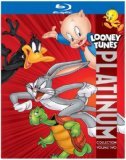| Reviews & Columns |
|
Reviews DVD TV on DVD Blu-ray 4K UHD International DVDs In Theaters Reviews by Studio Video Games Features Collector Series DVDs Easter Egg Database Interviews DVD Talk Radio Feature Articles Columns Anime Talk DVD Savant Horror DVDs The M.O.D. Squad Art House HD Talk Silent DVD
|
DVD Talk Forum |
|
|
| Resources |
|
DVD Price Search Customer Service #'s RCE Info Links |
|
Columns
|
|
|
Looney Tunes Platinum Collection: Volume Two
Back for a less mainstream second round
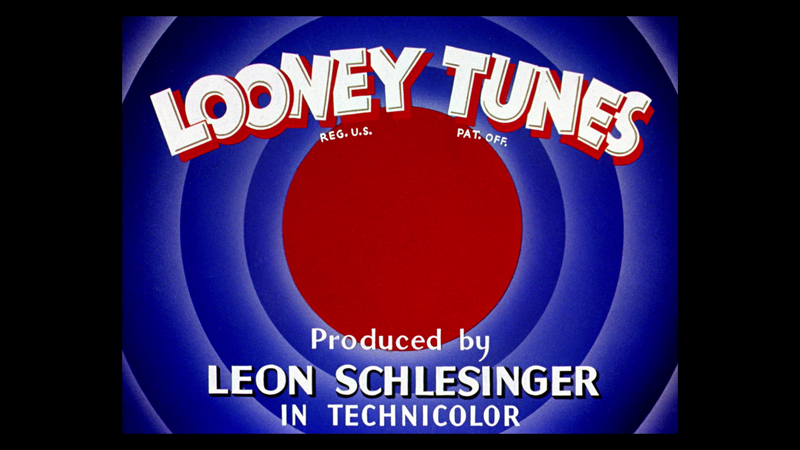
Reviewer's Bias*
Loves: Animation, quality packaging, excessive extras
Likes: Bugs Bunny, Ralph Phillips
Dislikes: Daffy Duck, Witch Hazel, Tweety
Hates: Double dips
The Story So Far...
Starting with theatrical shorts in 1930, the Looney Tunes series of cartoons has been going strong for decades, creating some of the most beloved cartoon stars of all time, including Bugs Bunny and Daffy Duck. Among the more than 1,000 cartoons created under the Looney Tunes banner are some of the most memorable shorts ever, including four listed on the National Film Registry, five Academy Award-winners and 26 Oscar nominees. There have been numerous DVD collections of the best-known shorts, including the acclaimed six-volume Golden Collection, while the cartoons made the jump to high-definition with the November 2011 release of the first volume of the Platinum Collection. DVDTalk has reviews of many of these titles.
The Shorts
The first volume in the Platinum Collection is loaded with some of the greatest Looney Tunes cartoons ever, so once fans were done enjoying the contents, their next thought would be, "What's next?" After all, considering the size and variety of Volune One, what could be left for Volume Two? Well, admittedly, many of the most well-known Looney Tunes were covered, so the second collection was certain to be a touch more esoteric and less mainstream. Fortunately, when you consider there are more than 1,000 Looney Tunes shorts out there, there are a few gems not yet released on optical disc, and this set brings home a few more of them, along with some lesser-known entries in the series.
The big shorts here are among the series' best, starting with Book Revue, an unusual cartoon that epitomizes what Looney Tunes could be. Traveling though a book store where the covers have come to life in puns on the titles, it's a musical adventure that eventually brings in Daffy Duck, but easily could have worked without any of the studio's big names. The pop-culture references and celebrity parodies may be less powerful these days (how many people under 40 can pick out a Danny Kaye reference), but it's the clever way everything flows that makes it so entertaining. Deduce, You Say is equally weird and referential, though it stars Daffy and Porky Pig as Sherlock and Watson stand-ins, making it a touch more recognizable as a Looney Tunes presentation. The animation, detailed, angular and darkly colored, makes it unique, while the storyline, involving the violent Shropshire Slasher, is smart and funny.
As is normally the case with the Looney Tunes, when you're talking quality, Bugs Bunny is mentioned in the same breath, and there are several top Bugs shorts in this set, with Long-Haired Hare and Ali Baba Bunny ranking among your reviewers' personal favorites. The battle between Bugs and opera singer Giovanni Jones in Long-Haired Hare is one of the inarguable classics of the series, and illustrates one of the key Looney Tunes themes: obsessive vengeance. So often, characters will experience a slight, real or perceived, and stop at nothing to destroy their foe, and few did it as well as Bugs, as he takes the conductor's baton and wreaks havoc on the singer in front of a live audience. He has a more worthy foe in Ali Baba Bunny, as he and Daffy take the fabled wrong turn at Albuquerque and end up intruding on a desert treasure guarded by the massive Hassan. Daffy's greed and Bugs' cool are formidable opponents, and the results of their three-way battle with the sword-wielding guard are memorable.
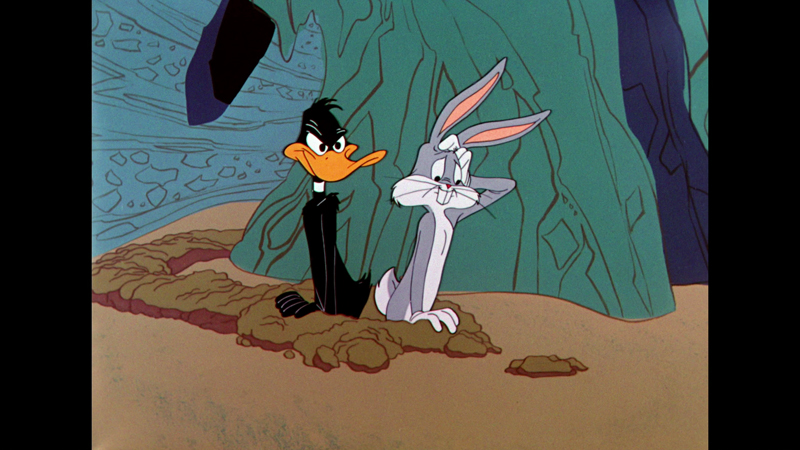
Surprisingly, two of the more entertaining shorts in this set feature the traditionally less-than-engaging Porky Pig, both of which come from the studio's early days, which is probably the reason why. Director Bob Clampett goes nuts all over Porky in Porky in Wackyland, easily the most surreal short ever to boast the Looney Tunes label. The only thing that could have made this any better would have been if it was in color, as one can only imagine the visual depravity Clampett could have mustered in color. You Ought to Be in Pictures is also unusual, as it blends live action with animation, as Porky breaks his Looney Tunes contract in the hopes of becoming a star. It's not the funniest of the run, but it's unique feel gives it a definite appeal.
Most of the other characters featured in this set, including Sylvester and Tweety, Foghorn Leghorn, Wile E. Coyote and the Road Runner, Pepe Le Pew and Speedy Gonzales, are not ones your reviewer traditionally enjoys, but this set managed to find a few highlights for some of them, like Sylvester's star-turns in Back Alley Oproar (yet another opera adventure) and Canned Feud (which captures the cat and mouse fun of Tom & Jerry) or the formulaic cleverness of the Road Runner gags in Zipping Along. Somehow, pairing two aggressively annoying characters like Daffy and Foghorn Leghorn even works here, as seen in The High and the Flighty. It should be no surprise though, that these are the works of masters Friz Freleng, Chuck Jones and Robert McKimson, which certainly helps the quality.
The fans were given a choice of episodes to include, and their selection was Wabbit Twouble. Though a fine battle between Elmer Fudd and Bugs, and noteable for the use of a Fudd-like speech impediment in the title and credits, it's not among the series' best offerings. It is however a fine segue into the second disc's collection of themed episodes, which start with the Hunting Trilogy, Jone's iconic trio of Bugs/Daffy/Elmer shorts that gave birth to "Duck Season" and the rather literate "pronoun trouble" joke. Though the gun play jokes are less acceptable today, every time Daffy's beak appears in another location, my six-year-old loses it. There's more hunting schadenfreude with Fudd and Porky trying to take down a proto Bugs in the four Early Wabbits cartoons. These definitely feel like works in progress, as the characters are nothing close to that they eventually will becme.
I was unaware the big thug who tries to swindle Bugs of his gold in Barbary-Coast Bunny had a name, but you get the complete Nasty Canasta here, three episodes in all, as he has a trio of wild-west adventures, two with Daffy. A presence to be certain, he's more of a visual gag than a great character. There are better battles to be found in the Bugs Bunny vs. Cecil Turtle Triology, three re-tellings of the tortoise and the hare tale. Perhaps the only character to continuously get an upper-hand on Bugs, Cecil's slow pace was a perfect foil for the sometimes manic Bugs, and with Tex Avery, Clampett and Freleng each taking a turn at the helm, this set is practically a Looney Tunes best-of.
Beaky Buzzard, the shy, goofy vulture whose laugh mimicked Mortimer Snerd's, has his own complete collection as well, with his four appearances, one with Bugs Bunny, and despite the set saying he was set for stardom if he hadn't lost his director and voice (to another studio and death, respectively) it's hard to see it. Beaky's basically a one-note character and that notes is basically borrowed from another character. The same goes for the two-part Complete A. Flea, starring the hillbilly flea looking for a home and a bite to eat, best remembered for his incredibly catchy song, "Food Around the Corner." The best part of this character is the intense Clampett-directed reactions the dog has to his new parasite.
A quintet of one-shots wraps up the shorts in this volume, representing a wide swath of concepts, from the Hollywood parodies of Hollywood Steps Out to the artistically-innovative Page Miss Glory, along with the uniquely Jones-ian Rocket-Bye Baby, the war-themed Russian Rhapsody and the animal action of Dough Ray Me-Ow. Free from the need to carry-on running gags and fit in popular behaviors or actions, these one-shots always seem a bit more creative and more cohesive in their storytelling. That's certainly the case with the visuals in Page Miss Glory, which has an art-deco feel, and Rocket-Bye Baby, which is simply gorgeous, especially when the UFO zooms around the city. Russian Rhapsody is interesting mainly because of the portrayal of Adolf Hitler and the Nazis battling Russian gremlins, but Dough Ray Me-Ow pits a dim-witted cat against a scheming parrot and ends up with a pile of hilarious gags that Avery somehow couldn't match when he did the same plot in a Droopy cartoon a year later.
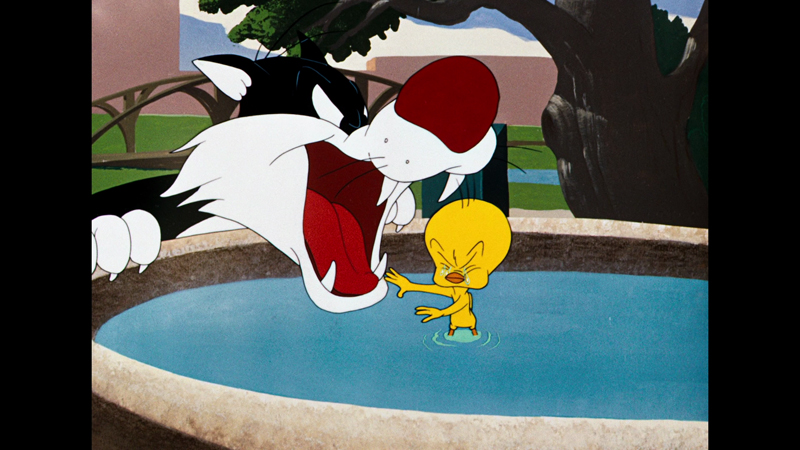
The Discs
This time around, the collection's not quite as extravagant, with the three discs held in a simple standard-width Blu-Ray case with a dual-hub tray, inside a holo-foil slipcover, with a 28-page booklet detailing the contents. The discs feature static menus offering options to play all the shorts, adjust languages, select cartoons and check out the special features. Audio options include English, Spanish and French 1.0 tracks, while subtitles are available in English SDH, Spanish, and German.
Of the shorts included 13 were not a part of the Golden Collection (at least not as stand-alone, restored shorts.) These new entries are indicated below in bold.
- A Wild Hare
- Buckaroo Bugs
- Long-Haired Hare
- Ali Baba Bunny
- Show Biz Bugs
- The Wise Quacking Duck
- What Makes Daffy Duck?
- Book Revue
- Deduce, You Say
- Porky in Wackyland
- You Ought to Be in Pictures
- Porky in Egypt
- Back Alley Oproar
- Little Red Rodent Hood
- Canned Feud
- Gift Wrapped
- Birdy and the Beast
- Home, Tweet Home
- Going! Going! Gosh!
- Zipping Along
- Scent-Imental Romeo
- The Foghorn Leghorn
- The High and the Flighty
- Tabasco Road
- Mexicali Schmoes
- Wabbit Twouble
- Rabbit Fire
- Rabbit Seasoning
- Duck! Rabbit, Duck!
- Drip-Along Daffy
- My Little Duckaroo
- Barbary-Coast Bunny
- Tortoise Beats Hare
- Tortoise Wins By a Hare
- Rabbit Transit
- Porky's Hare Hunt
- Hare-Um Scare-Um
- Prest-O Change-O
- Elmer's Candid Camera
- Bugs Bunny Gets the Boid
- The Bashful Buzzard
- The Lion's Busy
- Strife with Father
- An Itch in Time
- A Horsefly Fleas
- Hollywood Steps Out
- Page Miss Glory
- Rocket-Bye Baby
- Russian Rhapsody
- Dough Ray Me-Ow
The Quality
Overall, these 1080p, AVC-encoded transfers look tremendous in comparison to anything from the Looney Tunes library that you've seen before (with the obvious exception of the first volume of the Platinum Collection.) Colors are bright and rich, the level of detail is astounding (really showing off the artistry that went into the coloring of the backgrounds of these films) and the clarity of the black outlines and in-betweens makes for a beautiful package. You're going to experience a bit of variety in terms of how great the shorts look, with the lesser-known rarieties often looking less polished, a result of either a lower budget from the outset, age or a lack of well-preserved source materials. But taken all together, these shorts look as fresh and new as you could hope for from decades-old cartoons, and any imperfections you'll spot are almost charming in their lo-fi nature, as digital distractions are basically non-existent.
The Dolby Digital 1.0 tracks included on these shorts are certain sufficient for capturing the films' original sound, but when you stand them up against the beauty of the job done in restoring the visuals, they just feel a bit lacking in oomph. That will become exceedingly apparent as you find yourself pushing the volume-up button frequently to hear voices, music, sound effects...anything. Some of the shorts are very quiet, while others are decent in terms of volume. I found my volume level was often twice as high as when watching an average Blu-Ray on my system just to get an acceptable volume. The mix is a product of its time, sounding rather thin in comparison to today's cartoons.
The Extras
Extras? Yeah, there's a few here. If you care at all about these cartoons, or any cartoons at all, you could easily find yourself spending days making your way through the bonus content in this set. In terms of both the quantity and diversity of what you're getting, this is a treasure trove of animation history.
Things get started with the audio commentaries, which match the first set's massive 37 tracks (with another 38th on one of the extras,) featuring many of the same participants as the first set, including Paul Dini, John Kricfalusi, historians Michael Barrier and Jerry Beck and filmmakers like Greg Ford, Eric Goldberg and Mark Kausler, with participation from Jones, Clampett and McKimson. The tracks tend to be focused on the minutia and behind-the-scenes details that animation geeks will care about, with Goldberg delivering the best info (but with too few tracks this time) while Kricfalusi, with his knowledge and enthusiasm for animation, delivers the best tracks, at one point grilling an all-too-willing Bill Melendez for insider details (including one that seems to have been edited out, leaving dead air for a bit.) There are 11 new tracks that weren't a part of the Golden Collection, mainly from Ford and Kausler, along with tracks by Mel Blanc documentarian Constantine Nasr (working directly from notes) and historian Will Friedwald. Once again, the lesser-known one-shots get helpful, informative tracks, with each character grouping of shorts getting at least one track as well.
There are just 10 alternate audio elements this time around, down from 15 in the last set, with music and music-and-sound effects tracks that showcase the artistry of those parts of the shorts. Last time, there were vocals-only tracks as well, but there are none this time. The best part of this for an animation geek, aside from the opportunity to really appreciate the effort of syncing the music to the on-screen action, is hearing the recording as it was done, complete with an announcement of the number of the take.
There's a bit of good news/bad news when it comes to the huge assortment of featurettes and bonus cartoons included. For anyone who would want and expect an archival set like this to include previously available extras, you get them, as the majority of the extras have been ported over from the DVD Golden Collection sets, though in standard definition, rather than spiffy new high-def versions. But that means, for anyone who already has six volumes of Looney Tunes DVDs on their shelves, you've already seen much of this material. You'll also find that a lot of the information about the key players and characters is repeated frequently across the extras, as they come from across years of prodiction.
That said, there is some new stuff, starting with the HD "Leon Schlssinger: The Merrie Cartoon Mogul." Checking in at 20:24, it's a fine exploration of the man whose name was right up front on the Looney Tunes cartoons, looking at the history of his animation studio, his business practices and even his post-animation work. Though you'd be hard-pressed to come away from it seeing him as a visionary, his hands-off approach, a rarity for money-focused executives, was key to allowing his band of animators' talent to flourish. Later in the set you'll find "The World of Leon Schlesinger," (48:40) a collection of early shorts, including the a Bosko short that kicked off the company's growth, the title sequence from a John Wayne western he produced and footage from a company Christmas party (with commentary available from Beck and artist Martha Sigall.) These were available separately across the Golden Collection.
- Introduction by Beck and Sigall
- Bosko, The Talk-Ink Kid
- Sinkin' in the Bathtub
- Crying for the Carolines
- It's Got Me Again
- Haunted Gold Title Sequence
- Schlesinger Productions Christmas Party
The first set was heavy on Chuck Jones (for good reason), while this set puts a spotlight on the great Tex Avery, kicking off the tributes with "King-Size Comedy: Tex Avery and the Looney Tunes Revolution" (41:31), an in-depth history of the animator, and in a way, many of the Looney Tunes characters, as it follows his development of them, and focuses on his animation innovations, including his use of sexuality and meta jokes and his unwillingness to conform to the genre's conventions. "Tex Avery: King of Comedy" (52:06) is more of a straight-up biography of the man, with the feel of an "In Search Of" documentary, tracing the legend of Tex Avery, including his major (and not-so-major) characters and the thought-process that went into his classics. There's also the much shorter "A Conversation with Tex Avery" (7:06), where al older Avery talks about his career, while on the roof of the studio. Considering how much is heard about Avery in this set, it's nice to actually hear from him.
In addition to the documentaries and interview, 11 of Avery's non-Looney Tunes cartoons are available to enjoy here, featuring his classic Red Hot Riding Hood, Droopy Dog and some one-shots that show off his unique talent. The wordplay visuals of "Symphony in Slang" are great fun, while "Magic Maestro" may be the definitive revenge-on-an-opera-singer cartoon and the over-the-top oneupsmanship of "King-Size Canary" may be as good as anything Avery did. Personally, his characters like Screwball Squirell and Droopy, never resonated the way his work on the Looney Tunes did, but the work stands the test of time. (Note: these were not a part of the Golden Collection.)
- The Blitz Wolf
- Red Hot Riding Hood
- Screwball Squirrel
- Swift Shift Cinderella
- King-Size Canary
- Bad Luck Blackie
- Senor Droopy
- Wags to Riches
- Symphony in Slang
- Magical Maestro
- Rock-A-Bye Bear
Other animators get some focus as well, with "The Man from Wackyland: The Art of Bob Clampett" (21:11) and "Friz on Film" (54:41) (both carryovers from the Golden Collection.) I'll admit, I certainly knew less about these gentlemen than I knew about Jones or Avery, and these pieces helped fill in the gaps. "Wackyland" features a host of admirers and experts, including Kricfalusi and Frank Darabont, as they talk about his style and the focus on acting and faces, and his impact on the series' biggest characters, as well as his use of pop-culture references, all of which illustrate how ahead of his time Clampett was.
Friz Freleng's much longer feature is built around an interview with the man himself, as he discusses his life in animation, including his interactions with Walt Disney (not positive), his circuitous route to Looney Tunes, the team of animators he put together and his dislike for Elmer Fudd. It's nice to hear about some of the second-tier characters he worked on, as well as his post-Looney Tunes work on the Pink Panther. Also included here are five of his "Captain and the Kids" cartoons (43:59) he did for MGM. Though well-animated, the characters and stories pale in comparison to the Looney Tunes shorts on this set, however their inclusion is appreciated.
- Poultry Pirates
- A Day at the Beach
- The Captain's Christmas
- Seal Skinners
- Mama's New Hat
Also available on the first Golden Collection, "ToonHeads: The Lost Cartoons" (45:39) is more than welcome here, as this Cartoon Network special showcases 14 major rarities, some in their entirety, including the first Merrie Melodies cartoon and a look at a TV pilot for a live action/animation hybrid from Freleng and Richard Donner. Some of these are repeated elsewhere in this set (or on Volume One), but the remainder are a treat for animation fans. There's more in a similar vein in "Bosko, Buddy and the Best of Black and White" (9:28) a visit to the time of early sound animation, which explains why so many of the cartoons from that time look and sound the same, with Freleng adding his experience to the proceedings.
The rest of the featurettes were also available in the Golden Collection (and thus are in standard definition), starting with a handful of bits on the Looney Tunes and war. "Looney Tunes Go to War!" (10:18) looks at how the cartoons reflected the events in the world around them, including frequent depictions of the Nazis and Japanese, and how they were actively involved in the war effort, hawking war bonds and boosting American morale.
Among these efforts was the creation of Private Snafu, who's covered in "Real American Zero: The Adventures of Private Snafu." This 9:07 piece on the Schlesinger studio's contract work for the American military talks about why they decided to do cartoons to inform the troops, the crew that worked on them, the rather mature content matter and the involvement of big-name talent like Frank Capra and Dr. Suess. If this featurette makes you want to watch the cartoons, eight of them are available to check out, running 34 minutes. Featuring the clueless titular private and the gruff Technical Fairy, First Class, there to show him the error of his ways, these shorts told soldiers how to act during war time, including warning of them of spies and reminding them that the war effort continued back on the home front. Though straight-up propaganda, the animation and entertainment value are great.
- Coming!! Snafu
- Gripes
- Spies
- The Goldbrick
- The Home Front
- Rumors
- Snafuperman
- Censored
Seaman Hook was a less-impressive version of Snafu made for the Navy, with three cartoons (11:16) included in this set. Mainly these focus on the effort to get solider to create a nest-egg by buying bonds for post-military life, but there is Tokyo Woes, which is easily the most racist cartoon in this set, with a ridiculous depiction of the Japanese, buck teeth and all.
- The Good Egg
- The Return of Mr. Hook
- Tokyo Woes
Back to the world of the Looney Tunes for a few short featurettes, we get "A Hunting We Will Go: Chuck Jones' Wabbit Season Twilogy" (9:32) which offers a fine overview of the memorable three-episode arc between Elmer Fudd, Bugs and Daffy, with insight from experts and creators, and more Fudd in "Forever Befuddled," a quick (3:27) peek at the character's origin. The extras wrap up with "Looney Tunes Go Hollywood" (9:20), exploring the history of impersonations, homages and parodies in the series (and why their dated nature didn't matter to the animators), tied to the Hollywood Steps Out short.
Also included is a 28-page booklet, with a volume summary from Jerry Beck, descriptions of each short and info on the extras, along with some pretty art. Unfortunately, it's not all accurate, as some of the extras listed for Disc One are found on Disc Two. It could also use info like dates and lengths, but what you do get is good.
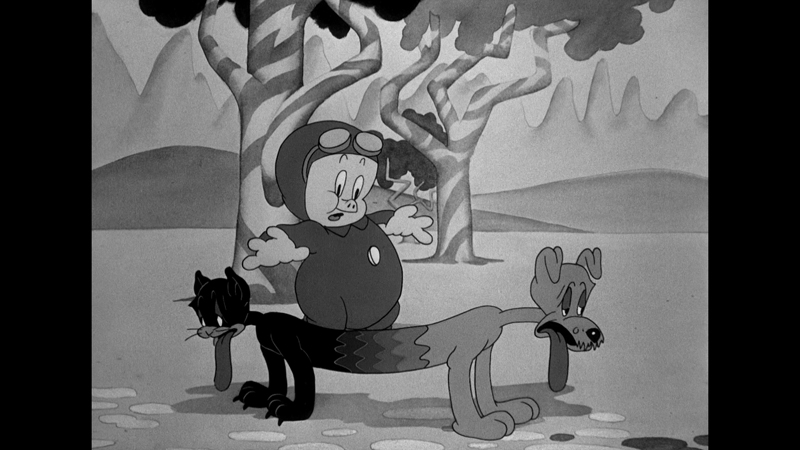
The Bottom Line
After delivering a huge pile of the most well-known Looney Tunes shorts in the first Platinum Collection, the question of what they would do for a follow-up was on many fans' minds. Now that we have the answer, we can rest easy, as we've received a nicely varied collection that includes more favorites and a great mix of rarities and curiosities (even if a majority of the content can be found in the Golden Collection DVDs.) Add in the hours of extras and the beautiful quality of the images, and this is another set that animation fans must add to their collection.
Francis Rizzo III is a native Long Islander, where he works in academia. In his spare time, he enjoys watching hockey, writing and spending time with his wife, daughter and puppy.Follow him on Twitter
*The Reviewer's Bias section is an attempt to help readers use the review to its best effect. By knowing where the reviewer's biases lie on the film's subject matter, one can read the review with the right mindset.
|
| Popular Reviews |
| Sponsored Links |
|
|
| Sponsored Links |
|
|
| Release List | Reviews | Shop | Newsletter | Forum | DVD Giveaways | Blu-Ray | Advertise |
|
Copyright 2024 DVDTalk.com All Rights Reserved. Legal Info, Privacy Policy, Terms of Use,
Manage Preferences,
Your Privacy Choices | |||||||









